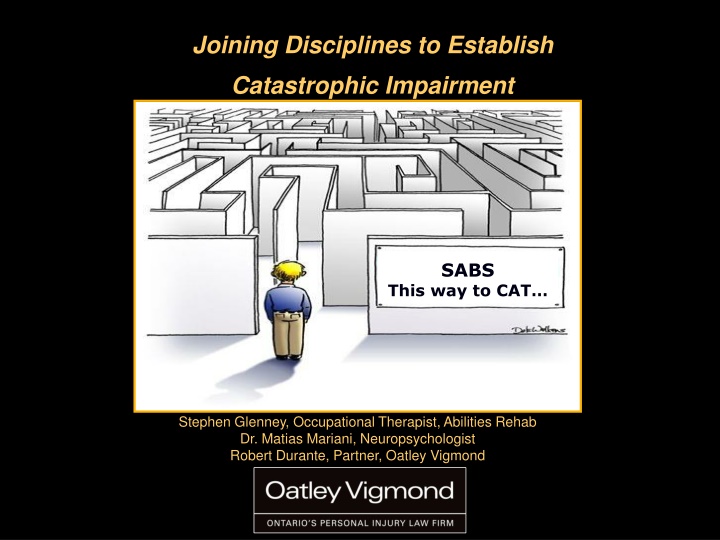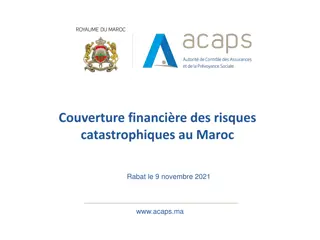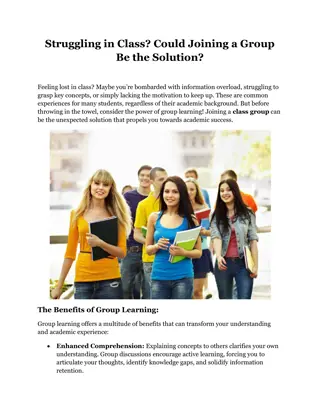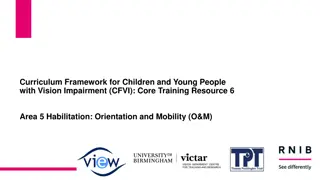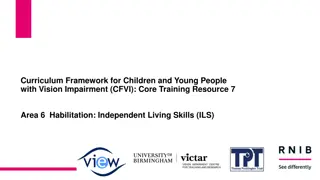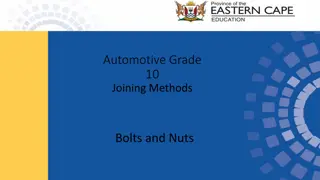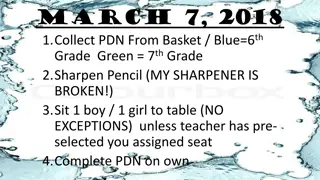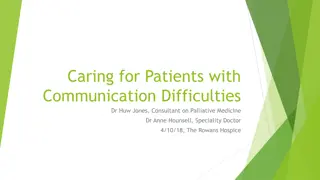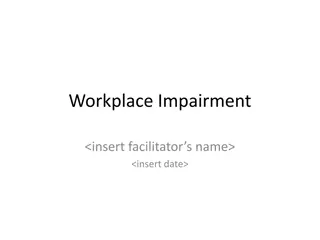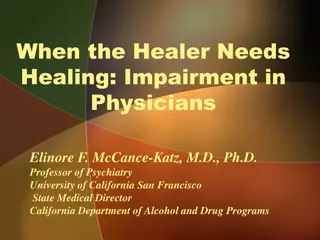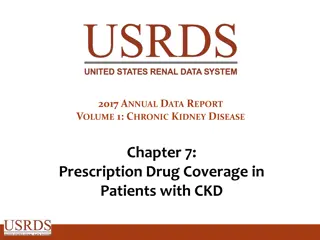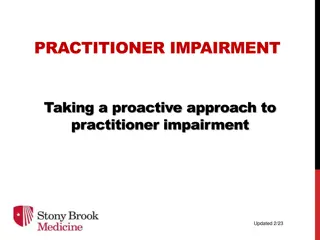Establishing Catastrophic Impairment: Joining Disciplines for CAT
Joining disciplines like occupational therapy and neuropsychology can help establish catastrophic impairment for the Catastrophic Determination by GOSE Ratings. Learn about the new CAT criteria, Glasgow Outcome Scale-Extended, and more for assessing catastrophic injuries.
Download Presentation

Please find below an Image/Link to download the presentation.
The content on the website is provided AS IS for your information and personal use only. It may not be sold, licensed, or shared on other websites without obtaining consent from the author.If you encounter any issues during the download, it is possible that the publisher has removed the file from their server.
You are allowed to download the files provided on this website for personal or commercial use, subject to the condition that they are used lawfully. All files are the property of their respective owners.
The content on the website is provided AS IS for your information and personal use only. It may not be sold, licensed, or shared on other websites without obtaining consent from the author.
E N D
Presentation Transcript
Joining Disciplines to Establish Catastrophic Impairment SABS This way to CAT Stephen Glenney, Occupational Therapist, Abilities Rehab Dr. Matias Mariani, Neuropsychologist Robert Durante, Partner, Oatley Vigmond
New Catastrophic Criteria Consider As of June 1, 2016, the CAT definition contained in the SABS has a word count of 1,131 In contrast, the prior definition tallied to just 276! Visit www.accidentbenefitsontario.com for details of the current criteria
New CAT criteria An adult is considered CAT as a result of a TBI if they meet the following criteria: The injury shows positive findings on a CT scan, or MRI, or any other medically recognized brain diagnostic technology indicating intracranial pathology that is a result of the accident 1. And
New CAT criteria When assessed in accordance with the Glasgow Outcome Scale and the Extended Glasgow Outcome Scale the injury results in a rating of: 2. Vegetative State (VS or VS*), one month or more after the accident, Upper Severe Disability (Upper SD or Upper SD*) or Lower Severe Disability (Lower SD or Lower SD*), six months or more after the accident, or Lower Moderate Disability (Lower MD or Lower MD*), one year or more after the accident. *pre-existing disability that impacts on the rating
What Is The Glasgow Outcome Scale-Extended (GOSE)? Standardized interview used to categorize level of disability following a head injury. The scale reflects disability and handicap rather than impairment. It looks at an individual s overall functioning in important areas of life.
Catastrophic Determination by GOSE Ratings categories: Dead, Vegetative State, Severe Disability, Moderate Disability or Good Recovery. The Extended GOS (GOSE) provides more detailed categorization into eight categories by subdividing the categories of severe disability, moderate disability and good recovery into a lower and upper category: Table 1: Extended Glasgow Outcome Scale (GOSE) Use of the structured interview is recommended to facilitate consistency in ratings. Glasgow Outcome Scale The Glasgow Outcome Scale (GOS) is a global scale for functional outcome that rates patient status into one of five 1 Death D 1+ Month 2 Vegetative state VS 3 Lower severe disability SD - 6+ Month 4 Upper severe disability SD + 1+ Year 5 Lower moderate disability MD - 6 Upper moderate disability MD + 7 Lower good recovery GR - 8 Upper good recovery GR + References: Jennett B, Bond M: Assessment of outcome after severe brain damage. Lancet 1:480 484, 1975. Teasdale GM, Pettigrew LE, Wilson JT, Murray G, Jennett B. Analyzing outcome of treatment of severe head injury: A review and update on advancing the use of the Glasgow Outcome Scale. Journal of Neurotrauma 1998;15:587-597. Wilson JTL, Pettigrew LEL, Teasdale GM. Structured interviews for the Glasgow Outcome Scale and the Extended Glasgow Outcome Scale: Guidelines for Their Use. J Neurotrauma 15(8): 573-85. 1997. Wilson JT, Slieker FJ, Legrand V, Murray G, Stocchetti N, Maas AI. Observer variation in the assessment of outcome in traumatic brain injury: experience from a multicenter, international randomized clinical trial. Neurosurgery. Jul;61(1):123-8; discussion 128-9. 2007 .
Catastrophic Determination by GOSE Ratings 1+ Month post-MVA Vegetative (non-verbal) Unable to interact with the environment, unresponsive to commands 6+ Months post-MVA Severe disability Needs frequent help with daily activities or someone to be around most of the time. Unable to be left alone for up to 8 hours. Can be left alone at home for up to 8 hours, but Cannot be independent for 24 hours Cannot shop or travel locally without assistance 1+ Year post-MVA Lower Moderate disability Can be independent in home and travel/shop without assistance, but: Is unable to work, or can only work in a sheltered or non- competitive position (or unable to look after others at home at pre- MVA capacity) Rarely or never participates in social/leisure activities Experiences/exhibits constant, daily, and intolerable family and friendship disruptions due to psychological problems (e.g., personality changes, quick temper, irritability, anxiety and sensitivity mood, depression, unreasonable or childish behaviour). 2. 3. 5. 4. (WILSON, J., PETTIGREW, L. AND TEASDALE, G. STRUCTURED INTERVIEWS FOR GLASGOW OUTCOME AND THE EXTENDED GLASGOW OUTCOME SCALE. GUIDELINES FOR THEIR USE. J. NEUROTRAUMA 15 (8): 573- 85. 1997)
GOSE: 9 Questions Consciousness Independence at home (do they need prompting, reminders, cueing, or supervision?) Basic personal care tasks, medications Meal planning, preparation, safety Response to emergency situations Independence outside home - shopping/money management Independence outside home-travel (can they plan, manage money, behave appropriately in public?) Work Competitive vs. non-competitive Sheltered, need for accommodations, change in workload, demands, or skills, Social and leisure activities Changes in participation and/or attendance, reduction in frequency and/or quality of activities Family and friendships Return to normal life Most important factor in functional outcome 1. 2. 3. 4. 5. 6. 7. 8. 9.
4 Rules When Conducting The GOSE Must identify pre-injury status to determine change due to TBI. 1. Only pre-injury status and current status should be considered. Current status is defined as problems and capabilities evident over the past week or so. Ignore recovery to date. 2. The disability must be a result of physical or mental impairment. It must be considered if the person is in fact capable of something even though they don t actually do it. 3. Use the best source of information available. If the person lacks insight, a caregiver or companion should be consulted. Use standardized measures as appropriate to corroborate interview. 4.
Perils, Pitfalls, & Recommendations From Practice Validity How to coordinate between healthcare providers? Timing: 7 days Number of GOSEs: Look for convergent data and try to understand divergent findings Assessment materials: Practice effects? Reliability? Rely on your strengths within your scope of practice and controlled acts Find various ways to evaluate areas of functioning Collateral information In-vivo skills vs. reported functioning: subjective vs. objective Standardized testing Borderline result: give benefit of the doubt to the individual Narrative reports add clarity and richness to the classification provided Challenges (e.g., access to relevant data, financial restraints, timelines,
Focus Points Question #2b: Wilson article differs from form Frequent help means not being able to look after self for 8 hours. Simply leaving an individual alone at home for 8 hours with all necessities does not imply independence. Remember key words to determine independence (e.g., prompted, supervised) Questions #3/4: Capability to do, not actual shopping and travelling Question #5: An individual who is unable to keep a job without accommodations meets criteria
A Harsh Reality Achieving a CAT impairment for even our most seriously injured client is now more difficult Many who would have been CAT in past are not CAT under the current regime We must be pro-active in supporting our clients who may be forever classed as non-CAT
Questions will
Joining Disciplines to Establish Catastrophic Impairment SABS This way to CAT Stephen Glenney, Occupational Therapist, Abilities Rehab Dr. Matias Mariani, Neuropsychologist Robert Durante, Partner, Oatley Vigmond
